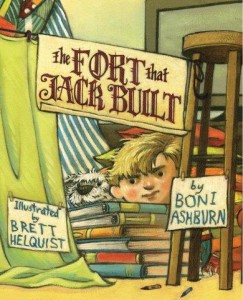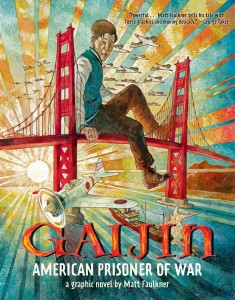Zapato Power: Freddie Ramos Stomps the Snow by Jaqueline Jules, art by Miguel Benitez (Albert Whitman & Co,, 2014 84 pages. Part of the Cybils award-winning Freddie Ramos series) This early chapter book will be a perfect hot summer read to cool off transitional readers. Freddie Ramos possesses an extraordinary pair of super powered shoes. He lives in Starwood Park apartment complex where people help each other. Freddie says he knows, “…what it was like to worry about rent money. Mom and I did before she got her job at the doctor’s office.” He attends Starwood elementary school with his friend Maria and her little brother, Gio. After a surprise March snow storm closes school and businesses, Freddie helps Mr. Vaslov, who takes care of the apartment complex, by clearing walkways. Freddie uses his Zapato Power! or super powered purple sneakers and wrist band. He goes so fast in them, he blows the paths clear of snow. He can jump two stories high which comes in handy when he’s looking for bad guys who inevitably pop up. Freddie, Maria and her little brother, (of whom Freddie says, ““some people can be bought with guacamole. Gio is one of them,”) enjoy their snow day by going sledding. But the storm also causes the heat to go out in Building D where Erika, a mean girl, lives. Erika and her grandmother and all the other residents take shelter in the school gymnasium, while Mr. Vaslov and Freddie make them comfortable. But the appearance of a Serial School Purse Snatcher who takes Erika’s abuela’s purse, then Maria’s, and even Freddie’s mom’s purse, threatens to ruin everything, until Freddie and his Zappato Power save the day.
Backseat Bookshelf and Other Summer Reads
All month, the ReaderKidZ are recommending summer reads for kids grades K-5 and NPR’s The Ultimate Back Seat Bookshelf: 100 Best Reads for Kids 9-14, (August 2013) is a great place to start if you’re looking for a solid list of novels to choose from. Don’t let the given age-range throw you. Many of the books are appropriate for a younger child, and some will make especially good read-alouds or audio books for the road.
For the picture book crowd, check out this short selection of new books.
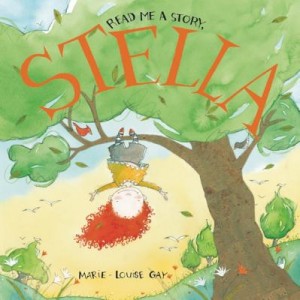
I’ve long been a fan of Marie-Louise Gay’s Stella books and Read Me a Story, Stella (Groundwood Books, 2013) is one of the best. Wherever Stella goes, little brother Sam goes too. Always, he’s got questions, and Stella, being the good big sister that she is, patiently answers. Even when it means she has to put down the book she’s reading.
When Fred, their dog, runs off with the kite string in his mouth, only to lose it minutes later, Stella is quick to comfort Sam.
“Will the kite get caught on a cloud?” cried Sam “Will it get burned by the sun?”
“Kites know their way around the sky,” said Stella. “They ride the wind until they find their way home.”
Watercolor illustrations capture the beauty of the the natural world and perfectly complement the tender relationship of the brother/sister duo.
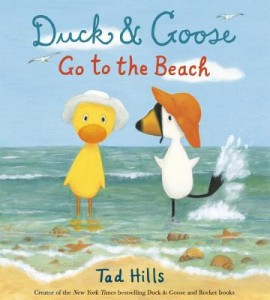
It’s been 7 years since the last Duck and Goose picture book and Duck and Goose Go to the Beach (Schwartz & Wade, 2014) by Tad Hills was definitely worth waiting for.
From the flap: “Duck wants to go on an adventure. Goose isn’t so sure. Together, the two feathered friends set off on a walk that takes them… all the way to a place they’ve never been – the beach!” But no sooner do they arrive that Duck starts having second thoughts. The beach is loud and he feels tiny next to SO MUCH water…
Text and illustrations capture the sweetness and humor of the relationship and adventures of these two completely opposite friends.
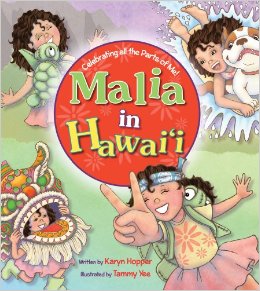
And finally, Malia in Hawai’i by Karyn Hopper, illustrated by Tammy Yee, celebrates the unique diversity of a little girl with a long name – Malia Sachi Ging Ging Lee. Readers will enjoy traveling with Malia around the island as she explores the fun and food of her Hawaiian home.
A heroic story about a young boy during war
It’s Alfie Summerfield’s fifth birthday when Stay Where You Are and Then Leave by John Boyne opens. By the end of this short, affecting middle grade novel, Alfie’s only nine, but in the intervening four years he’s been every bit as brave as his Dad, who’s gone off to fight for Britian in WWI. Alfie’s mom works a double shift at the hospital, so Alfie leaves school to earn money polishing shoes at King’s Cross Station. When his Dad’s letters stop, his mom tells him his Dad has been sent on a secret mission. Alfie’s convinced he’s dead. An encounter with a stranger while polishing his shoes gives Alfie a clue that his Dad may be a patient at a nearby hospital that treats soldiers suffering from shell shock. Determined to bring him home and restore his happy family, Alfie sets off to find him.
Boyne, the author of The Boy in the Striped Pajamas, has written a spare, moving story about war as seen through the eyes of a young boy. There’s prejudice in Alfie’s working class neighborhood, but there’s family love and loyalty, too. Alfie’s attempt to make sense of the world around him as it descends into the ravaging affects of men away at war and mothers trying to cope is a story for all times. And nine-year-old Alfie is nothing short of heroic.
Map Art Lab: 52 Exciting Art Explorations in Mapmaking, Imagination, and Travel
Taking a trip this summer? Why not preserve the memories of your travels in a creative, project-based way? Map Art Lab: 52 Exciting Art Explorations in Mapmaking, Imagination, and Travel is filled with plenty of intriguing labs that can do just that! Co-authored by siblings Linden McNeilly and Jill K. Berry, this book offers fifty-two well-planned innovative artistic projects, so many that you’re sure to find the perfect one to represent the joys of your summer excursions.
For instance, Lab 38 entitled ‘Magical Places’ (pg. 102-3) might be something you’d like to consider making if you’re taking a summertime trip of a lifetime. This lab is included in the Unit 5: Personal Map category. The example given is a graphic depiction of ‘The Beaches of My Childhood.’ It’s an awesome sequential display of seaside travels complete with street names, beach names, and a how-to-create illustration of an octopus and a pirate ship! (Nothing says summer fun like a seaside pirate ship.)
Consider Map Art Lab: 52 Exciting Art Explorations in Mapmaking, Imagination, and Travel as a resource for projects to creatively wrap up the family fun you will enjoy this summer – most certainly if pirate booty is in your future!
Librarian’s Corner: Summer Vacation Reads
Hooray for summer! As a school librarian, I love summer – maybe even more than my students. It’s the time of the year when I can catch up on all the wonderful books that I didn’t get a chance to read during the school year. I adore experiencing new worlds, people, and places from the comfort of my beach chair. Here are three favorites that are great to read beside the pool or snuggled up in a chair on a rainy summer day. – Melissa Buron
A Mighty Fine Time Machine by Suzanne Bloom
After Antoine and Grant trade all their candy for a non-working time machine, Samantha stops by with her wagon of books and helps her friends transform the box of hoozie-doozies into something which helps the friends travel, not only through time, but also all over the world – a Book Mobile! Bloom’s delightful illustrations and humorous text are perfect to wet the appetite of young readers for exploring, either by time travel or – even better – through the wonderful world of reading.
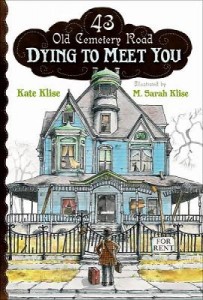 Dying to Meet You: 43 Old Cemetery Road by Kate Klise and illustrated by M. Sarah Klise
Dying to Meet You: 43 Old Cemetery Road by Kate Klise and illustrated by M. Sarah Klise
There are so many things to love about this book! Ignatius B. Grumply is a children’s author with writer’s block. When he rents an old run-down Victorian over the summer in order to finish his overdue manuscript, he is dismayed to find the house inhabited by an eleven year old boy, a cat, and a ghost. Broke and unable to leave until his manuscript is finished, Ignatius slowly forms a friendship with the boy, Seymour, and a creative partnership with the surprisingly prolific ghost. The story is told through letters, contracts, messages, and newspaper clippings. A fast read that will entertain both young reader and adult alike!
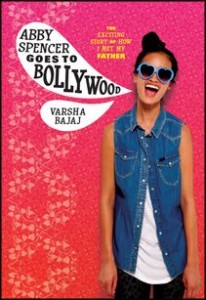 Abby Spencer Goes to Bollywood by Varsha Bajaj
Abby Spencer Goes to Bollywood by Varsha Bajaj
Abby wants more than anything to meet her father. When she finally makes contact, she is overwhelmed to discover he is a Bollywood superstar. In Mumbai, Abby discovers new family members, a new culture, and the beginnings of a first (and very innocent) romance. A wonderful and entertaining story that would be perfect for a long airplane ride or a lazy summer day.
For the past twenty years Melissa Buron has worked as a librarian and teacher for young people in Africa, Europe and the United States. In addition, she is an author, blogger and journalist. You can find her at www.melissaburon.com, or on Facebook, LinkedIn and Twitter (@melissaburon).
Librarian’s Corner: Cool Summer Reads!
Summer reading is, for me, all about reading for pleasure. Don’t worry about taking notes for book reports – just grab one of these titles, find a sunny spot, and enjoy!
For the youngest readers:
Duck, Duck, Moose! written by Sudipta Bardhan-Quallen and illustrated by Noah Z. Jones (Disney-Hyperion, 2014) This super-silly book is great for new readers because the only words to decode are “duck” and “moose”. Two tidy ducks live with an oddball moose (shown on the title page with underpants on his head.) Moose causes chaos for the ducks as they try to prepare for a party, but obviously the ducks love him anyway because the party is a surprise party for Moose.
The Fort that Jack Built written by Boni Ashburn and illustrated by Brett Helquist (Abrams, 2013) Ashburn takes the format of “The House that Jack Built” and deconstructs it, as Jack’s cool fort is taken apart piece by piece (a towel-wrapped mom takes back the shower curtain, to Jack’s dismay!) The ending is charming, and I love that it’s the grandmother who ends up down on the floor sharing a new fort space with Jack.
Gaijin: American Prisoner of War by Matt Faulkner (Hyperion, 2014) Koji’s life as a typical 13-year-old in San Francisco is turned upside down after the bombing of Pearl Harbor. Because he is half-Japanese, he is considered a threat to national security and sent to an internment camp along with thousands of others of Japanese descent. The art in this coming-of-age graphic novel is absolutely stunning. Note: this reviewer is the President of the Matt Faulkner Fan Club as well as his wife.
An exciting summer reading list from ReaderKidZ
Many schools around the country will stay in session longer this year, due to winter’s weather, but summer is ahead of us. Perhaps the days of that favorite season aren’t as long and lazy as they used to be; children lead busy lives these days. Still, summer is the perfect time for young readers to discover the joys of reading – the season when nothing else will do but to take a journey to a strange land, spend the afternoon with a favorite character, or tackle the next book in a beloved series. Countless studies, too, show that children who read over the summer hiatus do better when they return to school. Skills can be lost during time away. What better way to stay in shape than through reading?
For all of May, ReaderkidZ will recommend new and old favorites. Books to keep your children enthralled and entertained and, best of all, fluid readers. Please stay with us while we build an exciting summer reading list for K-5 readers.








